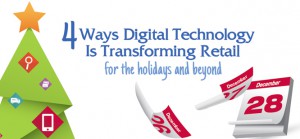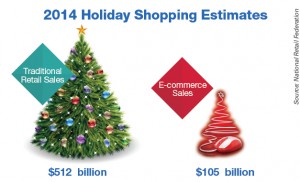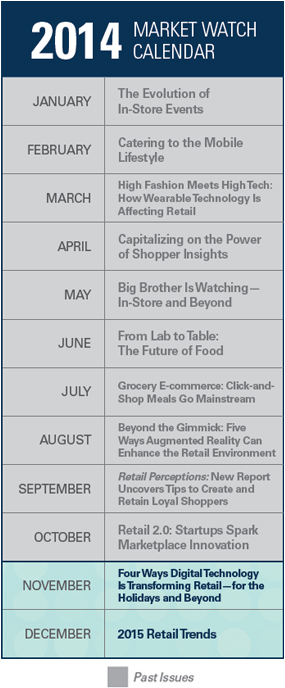 By Retail News Insider
By Retail News Insider
Over the past year, Retail News Insider has investigated a number of new digital technologies and the impact they are having—or are predicted to have—on the retail experience. One of the key takeaways from our coverage is that there’s little arguing that online shopping and mobile technologies have forever changed the way we as a society browse and shop for products—as well as how retailers interact with consumers.
Nowhere is this more apparent than in the latest predictions for the 2014 holiday shopping season. Here’s a look at the top four ways digital technology is transforming the retail experience—for the holidays and beyond.
1. Webrooming Makes Online Presence Key for All Retailers
Thanks to the wealth of information available, the Internet has come to play a significant role in researching everything from school projects and health information to product specifications and consumer reviews. More and more shoppers—88 percent, according to Interactions’ May 2014 Retail Perceptions survey “The Rise of Webrooming”—are turning to the web to conduct their shopping research, even when they ultimately plan to buy a product in-store.
According to Vikram Sharma, President and CEO of digital marketing firm G/O Digital, brick-and-mortar retailers can use webrooming to funnel shoppers to choose their store as the final purchase destination by aggressively focusing their resources on their digital presence and providing relevant content and in-store incentives through the digital medium. This is exactly what many retailers with a brick-and-mortar presence, including Sports Chalet, Lands’ End and Target, have done in recent months, launching new websites and apps to help capture shoppers no matter where they begin their shopping journey.
Matthew Shay, President and CEO of the National Retail Federation, says many more retailers are stepping up their digital presence in preparation for the 2014 holiday season in response to consumer demand. “Retailers have seen some momentum building and have devoted a fair amount of investment over the last several months preparing for the season,” said Shay in a recent press conference. “Some of those things, for example, include things like mobile and other digital platforms that are going to better inform consumers about where to find the products they want; [and] communication tools like live chat to interact with customers so we don’t have missed opportunities and so we don’t send customers to the wrong places.”
–Matthew Shay, President and CEO of the National Retail Federation
2. In-Store Tracking Personalizes the Shopping Experience
Another growing technology retailers are using to bring similar online tools into their stores is in-store tracking via special beacons that connect with shoppers’ mobile devices. Over the past year, retailers such as Macy’s, Lord & Taylor and Walgreens have started testing out the technology to offer special deals and more efficient shopping experiences to select shoppers who opt-in using a mobile app.
Though adoption has been somewhat limited to date, early retail adopters have already seen clear success. For example, according to research by mobile marketing firm inMarket, shoppers who receive location-based messages from beacons are 19 times more likely to interact with the advertised product as compared to shoppers who don’t receive such messages.
Because of its enhanced ability to connect with shoppers at the point of purchase, beacon technology will become part of the mainstream retail landscape this holiday season, predicts research firm eMarketer. Rob Murphy, Vice President of Marketing for iBeacon mobile marketing platform Swirl, stated in an interview with eMarketer that, “More than half of the top 100 retailers are actively working with beacon technology now—and they’re in different stages—but all of them are evaluating, testing, piloting, trying it out.” As the holidays approach, shoppers can expect to see more retailers deploying beacon-enabled technologies on a much larger scale, according to Murphy.

3. M-commerce Takes the Mobile Lifestyle to New Heights
Our connection to the digital world continues to grow, and more than one in three out of all smartphone and tablet owners now buys products directly via those devices, according to research firm Nielsen. So it’s hardly any surprise that 53 percent of retailers listed mobile among their leading key initiatives for 2014, according to Forrester Research.
Based on the biggest m-commerce innovation to hit the market this year, it must have been on Amazon’s list, too. The online retailer introduced its new Fire™ smartphone equipped with technology specifically designed to make it easier to shop Amazon.com using the mobile device. Users can scan a bar code on a package or even simply take a photo of a product and instantly be connected with “buy it now” options. Other retailers with a significant brick-and-mortar presence, including Target and Macy’s, have fired back by introducing their own product recognition apps that provide a list of similar products from their e-commerce sites when users snap a photo of a desired item using their mobile devices.
According to the National Retail Federation, a growing number of retailers are revamping their mobile sites and apps to enable a more streamlined m-commerce experience for the 2014 holiday season. In terms of actual dollars and cents, online news site Practical eCommerce predicts that 33 percent of total online sales will come from m-commerce. This could add up to over $34 billion in m-commerce spending in just the last 2 months of the year.
4. Stores Becomes Showrooms—for Retailers and E-tailers
 More than 60 percent of consumers now shop regularly online—and they have come to appreciate the convenience of ordering products and having them delivered directly to their doorsteps (often for free), rather than having to cart them home and/or return to the store to exchange a product. Yet, a significant number of shoppers still place high importance on being able to touch, feel and try out a product before making a purchase.
More than 60 percent of consumers now shop regularly online—and they have come to appreciate the convenience of ordering products and having them delivered directly to their doorsteps (often for free), rather than having to cart them home and/or return to the store to exchange a product. Yet, a significant number of shoppers still place high importance on being able to touch, feel and try out a product before making a purchase.
In response, some retailers and CPGs, such as Samsung and Miele, have experimented with using the store as a showroom—where shoppers are encouraged to browse, explore and try products, but ultimately buy them online. In an interesting turn of events, several big name online retailers are now following suit and jumping into the showroom-as-store game.
In the fashion arena, eyeglass e-tailer Warby Parker, online fashion label Everlane and menswear e-tailer Bonobos have all recently opened showrooms to give shoppers the best of both the online and in-store worlds. For the 2014 holiday season, Amazon recently announced plans to open “pop up” stores in San Francisco and Sacramento, and is reported to be eyeing a physical location in Manhattan, to allow shoppers to try its new Fire™ smartphone, TV and tablet, as well as the latest line of Kindle® e-readers.
If there’s any one lesson to be learned from the impact digital is having on the retail experience, it’s that there is no single “right” way to reach consumers. As Matthew Shay puts it, “The winners and losers… are going to be the retailers that have sorted out with a high degree of sophistication the way in which to maximize their inventory both through their distribution centers and in stores and mobile platforms… so they don’t miss those opportunities to sell to customers. Because once you miss them you might not get them back.”

